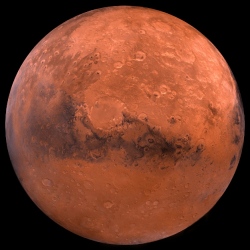
From Congress to NASA to Elon Musk, there’s been a lot of talk about humans going to Mars. Until recently, it’s been fanciful, given budget constraints, the mothballing of the space shuttle and Americans needing Russia to reach the International Space Station. But slowly, the red planet is coming into view.
The vehicles necessary are being built, research craft are being sent to survey the landscape and plans are being drawn up for a lunar way station. All that’s needed now is a target date. But when?
Is 2030 fantastical? 2033? 2040? The idea of getting the trip on the calendar was a subject of disagreement Tuesday at the Humans to Mars Summit, an annual gathering in Washington focused on how to make Mars happen.
“There’s going to be a time when we have to put a target date down,” Thomas Zurbuchen, NASA’s associate administrator for science missions, said during a panel discussion. “The challenge is to get humanity out of low-Earth orbit and out into deep space.”
The 1960s-era Apollo program to land U.S. astronauts on the moon was driven by President John F. Kennedy’s famous challenge and zealously funded by a Congress motivated by the Soviet Union’s perceived existential threat. Kennedy’s assassination in 1963 further drove the effort toward his goal, which was achieved by the crew of Apollo 11 in 1969.
NASA’s current planning for Mars isn’t driven by any such urgency. The agency’s priorities tend to change depending on the administration: Under President George W. Bush, NASA was directed to return to the moon, while President Barack Obama set Mars as the longer-term priority. The Trump administration aims to do both, planning a lunar “gateway” orbiter and landings on the moon’s surface, with heavy assistance from commercial firms—and then using those outposts as a leaping-off point for Mars.
Regardless of the precise schedule, NASA has made it clear that a human mission to Mars will require private enterprise, such as Musk’s SpaceX and its Falcon Heavy rocket, and a coalition of space-faring nations. The first crewed lunar gateway mission is planned for 2023 under NASA’s current plans, with humans heading to Mars in the 2030s. “Yes, we need a target date,” said Peter McGrath, a Boeing Co. space executive. “I’m waffling on whether it’s now or later.” Zurbuchen, NASA’s associate administrator, disagreed, saying: “I don’t think that time is now.”
Choosing a timeline has a scientific component in addition to a motivational one. Mid-2033 is one of the periods when Mars and Earth’s orbits near each other, slightly shortening what would now be a six-month journey to the planet, a key consideration.
In April, U.S. Representative Ed Perlmutter successfully advanced an amendment to press NASA to more formally plan a human mission to Mars in 2033. Perlmutter, a Democrat from suburban Denver, likes to distribute bumper stickers printed with the year 2033, and has one on his own car. On Tuesday, he waved one for the whole audience to see.
Setting a firm date “drives a sense of urgency and focus,” McGrath said. “If you don’t put something out there, you don’t have focus around what you’re defining as the plan.”
Eric Stallmer, president of the Commercial Spaceflight Federation, argued that a publicized target year for a human rendezvous with Mars is less important than sustained current budgets to advance the engineering and technical work that’s required.
